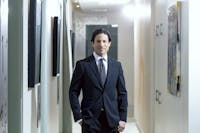During a fat grafting procedure, fat cells are extracted from a donor area using liposuction. They are then sterilized and purified for transfer to another area of the face or body that is lacking volume. The goal of fat grafting is to enhance the appearance of the recipient area in a natural manner with no risk of allergic reaction.
One of the key advantages of fat grafting is that it slims the donor areas, typically the thighs, stomach, hips or waist, places where most people desire a more sculpted physique. If you are interested in learning more about fat grafting in Beverly Hills and how it can help to provide more youthful-looking contours in the face and body, contact Dr. Cohen.
What is fat grafting?
Fat grafting is a versatile procedure that can be used to combat age-related volume loss in the face and body, fill in depressions caused by injury or trauma, and augment areas such as the breasts and buttocks. In the face, fat grafting works as an organic alternative to facial fillers and injectables. In the body, fat transfer can serve as a more subtle alternative to implants.
In order to graft fat, it must be harvested from an area of the body where it is plentiful. This is usually the belly, thighs, hips, or waist. By extracting fat from these “problem” zones, fat grafting both slims the donor areas and augments the recipient areas, accomplishing two cosmetic objectives at once. An outpatient fat grafting procedure typically takes about 2 hours to perform.
Fat grafting can be instrumental in providing supple volume in the following:
- Breasts
- Buttocks
- Hands
- Lips
- Cheeks
- Temples
- Jawline
- Eye area

What are the benefits of fat grafting?
- Provides longer-lasting results than dermal fillers
- Helps correct sunken, hollow-looking contours
- Refines the appearance of scars and depressions
- Rejuvenates the complexion
- Can augment the breasts and buttocks naturally
- Boosts volume in the lips
- Safe with no allergic reaction
- Can be performed in tandem with surgical procedures
- Aids in reconstruction after injury or trauma
How is a fat grafting procedure performed?
Fat is extracted from the donor areas using liposuction. A small incision is made at the target zone through which the doctor will insert a cannula, or small metal tube. The fat is then suctioned out and placed in a centrifuge to be purified and sterilized. Once it is ready for transfer, it is then injected into areas that require contouring and plumping. It may be necessary to repeat the fat grafting process several times in order to produce your ideal results. The goal is to achieve a naturally enhanced look using minimally invasive methods.
Who makes a good candidate for fat grafting?
In order to qualify for fat grafting, you should be a non-smoker in good mental and physical health with realistic expectations for your outcome. Secondly, you must possess an adequate amount of fat for harvesting in the stomach, thighs or hips. Patients seeking fat grafting in Beverly Hills should understand that their results will be subtle and natural-looking and that it might take several sessions to achieve their ideal aesthetic vision, especially when it comes to enhancing the breasts or buttocks.
What happens after fat grafting?
Our Beverly Hills fat grafting patients are usually able to return to work within about 2 days. Minor swelling and soreness may be present at both the donor and recipient sites for a few weeks. By using advanced liposuction techniques, Dr. Cohen is able to keep bruising to a minimum. The doctor will provide you with a detailed aftercare plan and you will attend follow-up visits to ensure you are satisfied with your results.
Why choose Dr. Cohen?
Dr. Cohen is a meticulously trained, award-winning, board-certified plastic surgeon who goes above and beyond to deliver exceptional results for his clients. His strategic treatments for the face, breasts, and body have garnered him a reputation for excellence as well as consummate artistry.
After graduating from Tulane University School of Medicine in New Orleans, Dr. Cohen attended an elite Ivy League program in plastic and reconstructive techniques at the Dartmouth-Hitchcock Medical Center, working side by side with among the industry’s top scientific minds. Dr. Cohen has been named a “Top Doc” in Phoenix Magazine and Castle Connolly.

